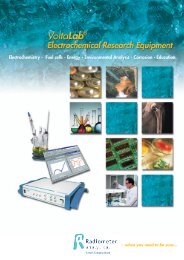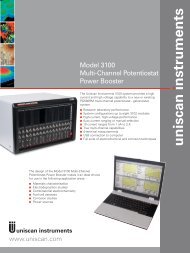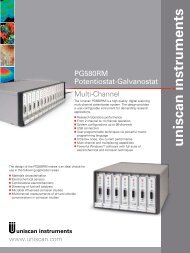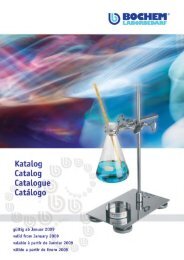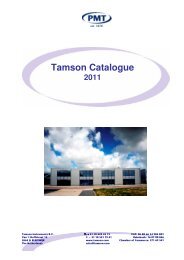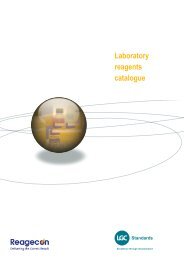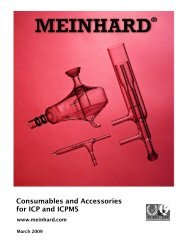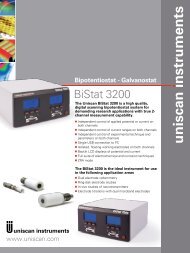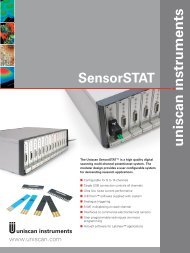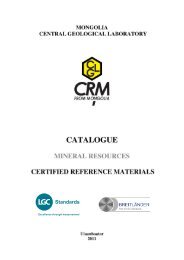REFERENZMATERIAL - Kohle REFERENCE MATERIAL - Coal
REFERENZMATERIAL - Kohle REFERENCE MATERIAL - Coal
REFERENZMATERIAL - Kohle REFERENCE MATERIAL - Coal
Erfolgreiche ePaper selbst erstellen
Machen Sie aus Ihren PDF Publikationen ein blätterbares Flipbook mit unserer einzigartigen Google optimierten e-Paper Software.
VORWORT<br />
B R E I T L Ä N D E R Eichproben + Labormaterial GMBH ist Spezialanbieter von Referenzproben seit dem Jahre 1972. Mit ca. 15000 Proben, die in unserer<br />
Datenbank erfaßt sind, bieten wir das umfangreichste Angebot an Referenzproben auf dem Weltmarkt. Unsere Datenbank gibt Auskunft über die Verfügbarkeit einer<br />
gesuchten Probe; der simultane Suchmodus erfaßt bis zu 8 Element-Konzentrationsbereiche von ppb bis 100%.<br />
Da wir nur mit der Herstellung von Silikatglas-Monitorproben für die RFA befaßt sind, können wir unsere Kunden herstellerunabhängig beraten und das am besten<br />
geeignete Referenzmaterial für Kalibrierung, Kontrolle oder Rekalibration empfehlen. Mit einem Lagerbestand von mehr als 2000 verschiedenen Proben können wir<br />
gängige Referenzmaterialien in den meisten Fällen prompt ausliefern. Zusätzlich zum eigentlichen Referenzmaterial können wir eine geeignete Probenvorbereitung<br />
empfehlen und dies mit unseren Maschinen auch praktisch demonstrieren, sowohl für die Metalle, als auch für oxidische Materialien.<br />
Referenzmaterialien, CRMs und RMs sind im ISO Guide 30: 1992 „Begriffe und Definitionen im Zusammenhang mit Referenzmaterialien“ von der Internationalen<br />
Organisation für Standardisierung (ISO) definiert.<br />
„CRM“ steht für „Certified Reference Material“ oder zertifiziertes Referenzmaterial, auch als „ZRM“ abgekürzt. CRM - von einem Zertifikat begleitetes<br />
Referenzmaterial mit einem oder mehreren Eigenschaftswerten, die durch ein Verfahren zertifiziert sind. Dieses Verfahren bescheinigt, daß die Werte auf ein<br />
exaktes Maß der Einheit zurückverfolgt werden können, in dem die Eigenschaftswerte ausgedrückt sind, und daß für jeden zertifizierten Wert eine Unsicherheit mit<br />
festgelegtem Zuverlässigkeitswert gegeben ist. CRMs werden zertifiziert durch eine anerkannte Zertifizierungsorganisation nach erprobten Verfahren, gemäß ISO<br />
Guide 35: 1989 „Zertifizierung von Referenzmaterialien – allgemeine und statistische Grundsätze“. Solche Zertifizierungsorganisationen sind gewöhnlich staatliche<br />
oder staatlich anerkannte Institutionen. Ein CRM hat die höchste hierarchische Stellung, die ein Referenzmaterial erhalten kann, weil eine direkte Rückführbarkeit zu<br />
SI-Einheiten angestrebt wird und wegen des ihm zugeschriebenen Vertrauens, das der Herausgeber genießt.<br />
„RM“ steht für „Reference Material“ oder Referenzmaterial. RM - Material oder Substanz mit einem oder mehreren Eigenschaftswerten, die ausreichend homogen<br />
und konstant sind, um zur Eichung eines Instruments, zur Bewertung eines Meßverfahrens oder zur Zuweisung von Materialwerten verwendet zu werden. Solche<br />
Referenzproben sind normalerweise im Rahmen einer Ringanalyse von verschiedenen Analytikern untersucht und werden mit einem Analysezertifikat ausgeliefert,<br />
das nicht immer alle Zertifizierungsvorschriften nach ISO Guide 35 erfüllt, oder auf anderen Zertifizierungskriterien beruht, z.B. durch Rückführbarkeitsmessungen<br />
auf NIST-Standards (tracebility to NIST). Einige Hersteller geben sehr gut dokumentierte Zertifkate heraus, das Zustandekommen der Analysewerte (Anzahl der<br />
unabhängigen Laboratorien, Methoden, Unsicherheiten etc) ist jedoch nicht bei allen Herausgebern vollständig beschrieben.<br />
„SUS“ steht für „Setting-Up Samples“ oder Rekalibrierproben. Es sind Materialien besonders geprüfter Homogenität, die angegebene quantitative<br />
Zusammensetzung ist jedoch nicht zertifiziert. Solche Proben werden zur Überprüfung und Aufrechterhaltung der Signalstabilität des Spektrometers benutzt, indem<br />
ihnen bei der Kalibrierung mit CRMs und RMs ein entsprechender Meßwert zugewiesen wird. Solche Proben werden auch als Geräte-Monitorproben bezeichnet, die<br />
Beschaffung einer hinreichenden Anzahl von Proben aus einer Schmelze wird angeraten, um neuerliche Dateneingabe bei nicht identischer Folgeschmelze zu<br />
vermeiden.<br />
„Kontrollproben“ sind eigentlich den Referenzproben zuzurechnen, es handelt sich normalerweise um typische Legierungsqualitäten. Sie sind hinreichend gut<br />
analysiert für den gewünschten Einsatzzweck, nämlich für die statistische Kontrolle des Spektrometers für Qualiätssicherungsaufgaben, Überprüfung von<br />
Kalibrierung und Rekalibrierungsbedarf.<br />
Die Referenzmaterialien dieses Kataloges sind entsprechend den o.g. Kategorien gekennzeichnet. CRMs müssen nicht von einer regierungsamtlichen Organisation<br />
herausgegeben werden, allerdings ist die Akkreditierung (Qualitätssicherung nach ISO 900x) eines Herausgebers oder eines an der Ringuntersuchung beteiligten<br />
Labors keine hinreichende Qualifizierung für eine Einstufung als CRM nach ISO Guide 30. Nur wenn der Herausgeber eine staatliche Einrichtung ist oder eine<br />
spezielle Akkreditierung gemäß ISO Guide 34 für das entsprechende Material besitzt, ist dies als CRM gekennzeichnet. Es sei ausdrücklich daraufhingewiesen, daß<br />
ein ISO 900x akkreditierter Herausgeber von Referenzmaterial durch eine solche Registrierung keine CRMs produziert.
Die in unseren Katalogen angegebenen Analysedaten sind als typische Werte zu betrachten, normalerweise in Gewichtsprozenten ausgedrückt, falls nicht als ppm,<br />
µg/g, mg/kg oder anders gekennzeichnet. Sie wurden sorgfältig nach Herstelllerangaben dokumentiert, Irrtum und auch Änderungen durch Folgeschmelzen kann<br />
nicht ausgeschlossen werden, gültig ist allein das zu der Probe mitgelieferte Zertifikat. Klammerwerte kennzeichnen nicht zertifizierte, nur informative Werte. Da<br />
Referenzproben aus Homogenitätsgründen normalerweise nur in sehr begrenzter Stückzahl zertifiziert werden können, haben Folgeschmelzen keine identische,<br />
sondern eine sehr ähnliche Zusammensetzung; auch die Probenabmessung kann sich ändern. Wir geben Ihnen gerne die tatsächlich vorliegenden Werte an, auch<br />
die Unsicherheiten, Bestimmungsmethoden etc. Sie können dies vor Bestellung bei uns erfragen. Wir geben Ihnen ferner alle weiteren uns vom Hersteller<br />
überlassenen Informationen. Zur Beachtung: prüfen Sie, ob die Werte des mitgelieferten Zertifkates Ihren Erfordernissen entsprechen bevor Sie ein gekauftes<br />
Referenzmaterial benutzen; wir akzeptieren nach Abstimmung Rückgaben innerhalb von 60 Tagen nach Lieferung nur für unbenutztes Material.<br />
Die Auswahl geeigneter Referenzproben ist von besonderer Wichtigkeit für Ihre interne Qualitätssicherung und gegenüber Forderungen externer<br />
Abnahmegesellschaften. Dabei sind zwei Kriterien von besonderer Bedeutung: der o.g. metrologische Status der verschiedenen Proben und die Kongruenz des zu<br />
untersuchenden Materials mit dem der Referenzproben. Vergleichbares Probengefüge und gleiche Probenvorbereitung sind dabei wichtige Kriterien, die<br />
Kalibrierkurven sollten auf einer möglichst großen Anzahl von matrixähnlichen Referenzproben basieren. Auf die Empfehlungen der Gerätehersteller wird besonders<br />
hingewiesen. Bei Einsatz von Qualitätssicherungsprogrammen sollen gemäß internationalen Normen z.B. ISO 900x CRM-Proben eingesetzt werden, sofern diese<br />
für das zu untersuchende Material zur Verfügung stehen. Leider ist das Angebot an CRM-Proben beschränkt, so daß in der Praxis eine Kombination von<br />
verfügbaren CRM- und RM-Proben notwendig und sinnvoll ist. Aufgrund zufallsbedingter und auch systematischer Unsicherheitseffekte bei allen analytischen<br />
Messungen ist es unwahrscheinlich, daß die von einem Anwender erzielten Messwerte eines Referenzmaterials genau mit dem Zertifikat übereinstimmen. Wichtig<br />
ist, daß sich die Meßergebnisse in einem für den Verwendungszweck akzeptablen Toleranzbereich bewegen.<br />
In unseren Katalogen sind die technologischen Eigenschaften der Proben, so weit bekannt, angegeben: „wrought“ kennzeichnet gewalzte, gezogene oder<br />
geschmiedete Metallproben, „cast“ bezeichnet gegossene Proben und „chill cast“ steht für Proben, die zur schnellstmöglichen Abkühlung, normalerweise auf einem<br />
Kupferblock, vergossen wurden. Bei Aluproben liegt bei den zylindrischen Proben im allgemeinen Extrudierung vor, die flachen Pilzproben sind Kokillenproben.<br />
Bestimmte Proben, die flüchtige Elemente enthalten, haben einen Kataloghinweis auf diese Konzentrationsbereiche – im Zertifikat sind die tatsächlichen Werte. Da<br />
die meisten Aluproben von den Aluminium-Großherstellern kommen (RM-Proben) sind nur die wenigen CRM-Proben als solche im Katalog gekennzeichnet. Bei<br />
einer Reihe von geochemischen Referenzproben sind neben der chemischen Zusammensetzung auch eine mineralogische und granulometrische<br />
Zusammensetzung angegeben. Auf Anfrage teilen wir Ihnen mit, ob eine solche erweiterte Aussage im Zertifikat gemacht wird.<br />
Bitte fragen Sie auch nach Referenzmaterial an, das Sie nicht in unseren Katalogen finden, wir recherchieren für Sie und könnnen evtl. auch Material für Sie fertigen<br />
lassen, dank unserer langjährigen Kontakte zu spezialisierten Instituten und Laboratorien.<br />
Bestellungen erbitten wir per Brief, Fax, e-mail oder auch telefonisch. Bei schriftlichen Aufträgen, die telefonische Aufträge bestätigen, erbitten wir einen<br />
entsprechenden Hinweis, um Doppelbestellungen zu vermeiden. Bitte geben Sie an: Menge, vollständige Art.-Nr. lt. Katalog, Materialbezeichnung und Preis, falls<br />
bekannt. Unsere Preise verstehen sich in EURO, Erfüllungsort Hamm. Wir berechnen keine separaten Verpackungskosten und liefern Nicht-Gefahrgut franko Werk<br />
des Empfängers im Inland. Besondere Zustellbedingungen und Gefahrgut-Transportkosten werden zusätzlich berechnet, Gefahrgut-Artikel sind in unseren<br />
Katalogpreislisten gekennzeichnet, die Zusatzkosten richten sich nach Eilbedürftigkeit, bitte fragen Sie an. Alle Verkäufe erfolgen ausschließlich zu unseren<br />
allgemeinen Verkaufsbedingungen. Zahlung: innerhalb von 30 Tagen netto Kasse bei gesicherter Bonität, bei Inlandsgeschäften gewähren wir 2% Skonto bei<br />
Barzahlung innerhalb von 14 Tagen nach Rechnungsdatum. Wir liefern normalerweise bei Lagerproben prompt nach Auftragseingang, Nicht-Lagerproben<br />
beschaffen wir innerhalb von 2-4 Wochen.<br />
Bitte richten Sie Ihre Bestellung an: BREITLÄNDER GMBH Tel. 02381 / 40 40 00<br />
Hans-Sachs-Str. 12 Fax 02381 / 40 31 89<br />
D-59077 HAMM email: mail@breitlander.com<br />
Deutschland homepage: www.breitlander.com
Preface<br />
B R E I T L Ä N D E R Eichproben + Labormaterial GmbH have been specialist in reference materials since 1972. With about 15000 international reference<br />
materials included in our database, we supply the world’s most comprehensive range of standards. Our database tells you the availability of particular materials of<br />
interest with up to 8 selected element or compound concentrations searched for simultaneously in the range from ppb to 100%.<br />
As we specialise in production of XRF-glass-monitor samples only we can advise customers independently and help to select the most appropriate reference<br />
material for calibration, control or setting-up. We carry in stock a range of more than 2000 different materials and can satisfy most customer requirements for same<br />
day supply. Further to reference materials we can advise the customer on correct sample preparation either in the field of metals or for mineral based materials; we<br />
supply from stock sample preparaton machines as well as consumables.<br />
Reference materials, CRMs and RMs, have been defined as per ISO Guide 30: 1992 „Terms and definitions used in connection with reference materials“ issued by<br />
the International Standards Organization.<br />
CERTIFIED <strong>REFERENCE</strong> <strong>MATERIAL</strong> (CRM): Reference material, accompanied by a certificate, one or more of whose property values are certified by a procedure<br />
which establishes its traceability to an accurate realization of the unit in which the property values are expressed, and for which each certified value is accompanied<br />
by an uncertainty at a stated level of confidence. The CRMs are certified by a recognized certifying organization using approved certification procedures as<br />
instructed in ISO Guide 35: 1989 „Certification of reference materials – General and statistical principles.“ The organization is usually a function of a federal<br />
government or recognized by a federal government. A CRM is the highest level to which an analytical reference material can be elevated because it is directly<br />
traceable to SI units and because of the attributed confidence in the company or organization which produced the material.<br />
<strong>REFERENCE</strong> <strong>MATERIAL</strong> (RM): A material substance one or more of whose property values are sufficiently homogeneous and well established to be used for<br />
calibration of an apparatus, the assessment of a measurement method, or for assigning values to materials. The RMs usually have been through interlaboratory<br />
testing using many analysts and supplied with a certificate of analysis but do not strictly follow all the procedures of certification as indicated in ISO Guide 35.<br />
Certificates of RMs often state that the measurement data are traceable to primary CRMs, mostly expressed as traceability to NIST.<br />
SETTING-UP SAMPLES (SUS): Materials of minimum inhomogeneity to be used for monitoring or adjustment of the analytical signal of instruments. These<br />
materials are assigned values during calibration with CRMs or RMs, thus they do not need to have a certified analysis, but a guiding one only. Such standards are<br />
also called „recalibration samples“, „drift control samples“ or „monitor samples“.<br />
CHART CONTROL SAMPLES are selected RM-materials, their composition normally correspond to common alloy grades. These samples are sufficiently well<br />
analysed for their intended use to keep spectrometers in the state of statistical control and used for quality assurance, to check for calibration and recalibration.<br />
Reference materials in this catalogue have been coded as per above categories. CRMs, certified by a recognized certifying organization, needn’t to be<br />
governmental, however the accreditation of the issuing laboratory or that of one or more laboratories participating in the analysis does not fulfill the requirements for<br />
CRM coding as per ISO Guide 30. Only when the producer is a government agency or holds an accreditation specific to ISO Guide 34 for the material in question we<br />
have applied the term CRM in this catalogue. It should be clearly stated, that a reference material supplier, accredited as per ISO 900x does not produce CRMs,<br />
because of such a registration.<br />
The analytical data in our catalogues are given in mass percent, unless another unit is indicated (ppm, µg/g, mg/kg). They have to be considered as typical or pilot<br />
values, the proper values are to be found in the certificate only, supplied together with the sample. Values in brackets ( ) are not certified and listed for information<br />
only. Reference materials can only be produced in a limited number mostly because of homogeneity reasons, thus follow up melts will normally differ slightly in<br />
composition and may differ in dimensions between batches. In case you need an exact value or more information on manufacture, material property, methods,<br />
uncertainties etc prior to selection, do not hesitate to ask for information. We will pass on to you the information available from the producer, though not all of them<br />
supply complete background information. Please note: before using a material check that the values from the certificate are acceptable, material returns are<br />
acceptable within 60 days after shipment, please contact us in such cases beforehand, however such returns apply only for unused material.
Selecting appropriate reference materials improves efficiency of your quality assurance programme. Two features are of importance – their metrological status as<br />
indicated above and how their properties match those of the user’s routine samples. Due to increasing implementation of quality assurance programmes, growing<br />
emphasy is put on use of CRMs whenever available. International Standards like ISO 900x request CRMs, however the offer in certain areas is very limited.<br />
Therefore the optimum combination of CRMs and RMs has to be used.<br />
Our catalogue indicates the technological properties of the materials whenever available, essential mainly for solid metals, where the prevailing spectral analytical<br />
techniques are structure and surface sensitive.The solid metal samples have therefore been marked „wrought“, „cast“ and „chill cast“, the latter meaning rapid<br />
solidification, generally achieved by casting on a copper block. Aluminium samples in cylindrical form are usually extruded, the flat „mushroom“ ones are mold cast.<br />
Trend inhomogeneity in Al-samples caused by technology for some „burn out“ elements are individually certified by some producers, the range is given in the Alcatalogue,<br />
the exact value in the certificate. As most Al-samples are RMs coming from the leading aluminium producers, only the CRMs have been specially coded.<br />
Some certificates of geochemical samples not only list the chemical composition, but also the mineral and granulometric composition, on request we will let you<br />
know if the certificate indicates such information.<br />
Users are advised to select reference materials close to their own samples. They should have similar structure and be prepared exactly the same way. Calibration<br />
should be based on matrix compatible materials and graphs should be made of as many reference materials as available. The instrument manufacturer’s<br />
recommendations for calibration procedures should be followed. Analytical results always carry uncertainties due to random and systematic errors, thus it is unlikely<br />
that the measured value obtained from a CRM or RM exactly fits the certified one, important is that the results obtained are within acceptable tolerance for the<br />
applicational method used. In order to validate instrumental calibration classical chemical methods of analysis of customer’s own material and parallel running of<br />
other CRMs of same matrix is recommended and should indicate possible calibration differences.<br />
Should you look for a particular material you cannot locate in our catalogues, please inquire. We search for available reference materials, there might be new,<br />
recently issued materials and in some cases we can have material made and analysed for you. We are in close contact with specialised institutes and companies<br />
producing reference materials, as well as with the instrument producers.<br />
Ordering: We accept orders by mail, fax, e-mail or phone. Please clearly indicate written orders of previously given phone orders to avoid double ordering and state<br />
in your order: quantity, catalogue number, material description and price, if known. Prices are understood in EURO, fca Hamm, Germany, as per current price list.<br />
We do not charge for packing. Transport charges are added, normally air parcel postage, unless courier or airfreight is appropriate or requested, we ship as per<br />
customer request. Hazardous goods require special packing and higher transport costs, all items are listed in our price list as „GEFAHRGUT“, please inquire for<br />
additional charges depending on your time requirement and possibility of reduced collective transport rates. All sales are executed as per our conditions of sale.<br />
Delivery of stocked samples prompt after receipt of order/payment, non-stocked articles we normally have available within 2-4 weeks, faster service at extra charge,<br />
depending on source, is possible, too.<br />
Payment: we accept MASTER or VISA card, we issue proforma invoices for pre-payments, L/Cs for bigger orders acceptable, payable on a German bank, 100% at<br />
sight upon presentation of shipping documents and invoice, all banking charges for account of applicant, established customers with trade reference may apply for<br />
open account.<br />
Please send your order to: BREITLÄNDER GMBH Tel. ..49 (0) 2381 / 40 40 00<br />
Hans-Sachs-Str. 12 Fax ..49 (0) 2381 / 40 31 89<br />
D-59077 HAMM email: mail@breitlander.com<br />
GERMANY homepage: www.breitlander.com
Katalog Nr. 5 - <strong>Kohle</strong><br />
Catalogue No. 5 - <strong>Coal</strong><br />
Material Seite / Page<br />
<strong>Kohle</strong>n <strong>Coal</strong>s 5.1.1 ff<br />
Graphit und Anodenkohlen Graphite and Anode <strong>Coal</strong>s 5.1.6<br />
Pech Pitch 5.1.7<br />
Koks Coke 5.2.1 ff<br />
Torf und Bioheizstoffe Peat and Biofuels 5.2.3<br />
Mahlbarkeitsstandards HGI Grindability Standards HGI 5.2.4
B R E I T L Ä N D E R - E I C H P R O B E N <strong>Kohle</strong> (<strong>Coal</strong>) 5.1.1<br />
------------------------------------------------------------------------------------------------------------------------------------------------------------------------------------------------<br />
CRM <strong>Kohle</strong> 250 g<br />
AS 013-10A Asche (Ash) 9.81 ± 0.09<br />
flüchtige Teile (Volatile matter) 19.71 ± 0.18<br />
<strong>Kohle</strong>nstoff, ges. (Total carbon) 79.7 ± 0.32<br />
Wasserstoff (Hydrogen) 4.42 ± 0.08<br />
Stickstoff (Nitrogen) 1.75 ± 0.06<br />
Schwefel, ges. (Sulfur) 0.585 ± 0.014<br />
Schwefel (Sulfur), pyrit. 0.046 ± 0.020<br />
Schwefel (Sulfur), sulf. 0.009 ± 0.002<br />
<strong>Kohle</strong>nstoff, karbonisiert (Carbonate carbon) 0.032 ± 0.007<br />
Chlor (Chlorine) 0.053 ± 0.007<br />
Phosphor (Phosphorus) 0.036 ± 0.003<br />
Spezif. Energie, ges. (Gross specific energy) 32.4972 ± 0.072 MJ/kg<br />
relative Dichte (Relative density) 1.368 ± 0.03125<br />
CRM<br />
Elektrodenkohle (Electrode carbon)<br />
AS 003-2 Spezifikation Stahlwerkselektrodenkohle 1500g Zertifikat wird auf Anfrage zur Verfügung gestellt; Certificate on request<br />
Feuchtigkeit (Moisture)
B R E I T L Ä N D E R - E I C H P R O B E N <strong>Kohle</strong> (<strong>Coal</strong> )<br />
5.1.2<br />
---------------------------------------------------------------------------------------------------------------------------------------------------------------------------------------------<br />
CRM SiO 2<br />
Al 2<br />
O 3<br />
Fe 2<br />
O 3<br />
TiO 2<br />
CaO MgO Na 2<br />
O K 2<br />
O P 2<br />
O 5<br />
S As Ba Be Ce Co Cr Cu Cs<br />
X 18 6.20 2.57 0.29 0.114 0.18 0.11 - 0.145 - 0.56 - 0.0078 0.00041 0.0022 0.00067 0.0016 0.00059 (0.0001)<br />
X 19 15.00 8.01 1.75 0.341 1.39 0.20 0.29 0.24 - 1.49 0.0007 0.0304 0.00028 0.0056 0.00056 0.0050 0.0013 0.00014<br />
X 20 17.66 11.27 1.17 0.63 1.87 0.43 0.27 0.14 0.14 0.51 0.00047 0.0372 0.00025 0.0087 0.00083 (0.0067) 0.0018 (0.0002)<br />
Hf La Mn Ni P Rb Sc Sm Sr Th U V Zn Zr B Br Cl Eu<br />
0.00017 0.0010 0.0022 0.00108 0.0030 0.00081 0.00043 0.00020 0.0044 0.00034 0.00015 0.0023 0.00055 0.0067 (0.0030) (0.0003) - (0.00003)<br />
0.00054 0.0027 0.0157 0.0016 0.0130 0.0009 0.00076 0.00049 0.0126 0.0012 0.0005 0.0035 0.0012 0.0351 (0.0090) (0.0002) (0.0032) (0.00007)<br />
0.00048 0.0043 0.0080 0.0025 - 0.0010 0.0010 0.00063 0.0330 0.0018 0.0004 0.0047 0.0017 (0.0180) (0.0090) (0.0002) - (0.0001)<br />
Ga Ge Hg Nb Pb Sb Se Sn Ta Tb W Y LOI 120 g<br />
(0.0008) (0.0008) (0.000004) 0.0006) (0.0005) (0.00003) - (0.0001) (0.00003) (0.00003) (0.0002) (0.0012) 90.11 <strong>Kohle</strong>, bituminös; <strong>Coal</strong>, bituminous<br />
0.0014 0.0013 (0.00002) (0.0010) 0.0020 (0.00003) (0.0001) (0.0003) (0.00008) (0.00007) (0.0002) (0.0020) 71.28 <strong>Kohle</strong>, subbituminös; <strong>Coal</strong>, sub-bituminous<br />
0.0016 - 0.000025 (0.0016) 0.0026 (0.00004) 0.00008 (0.0004) 0.00012 (0.00009) (0.0003) 0.0029 64.66 <strong>Kohle</strong>, subbituminös; <strong>Coal</strong>, sub-bituminous<br />
CRM Fe 2<br />
O 3<br />
CaO Al 2<br />
O 3<br />
SiO 2<br />
S Ash ppm MgO ppm Na 2<br />
O ppm K 2<br />
O ppm P 2<br />
O 5<br />
ppm TiO 2<br />
ppm Ba ppm Ce ppm Co ppm Cr ppm Ni ppm Pb ppm Rb<br />
UG CLB-1 1.25 0.22 1.51 2.51 1.49 6.3 470 230 760 700 780 34 10 7.0 9.7 18 5.1 5.2<br />
ppm Sc ppm V ppm Zn ppm As ppm Cu ppm Ga ppm Hg ppm La ppm Li ppm Mn ppm Mo ppm Nb ppm Nd ppm Sb ppm Se ppm Th ppm U 50 g<br />
2.0 12 48 13 10 3 0.2 5 8 8 9 1 5 1.5 2 1.4 0.55 <strong>Kohle</strong><br />
<strong>Coal</strong><br />
UG CLB-1 <strong>Kohle</strong>, bituminös; <strong>Coal</strong>, bituminous<br />
CRM C H N Cl Al ppm As ppm B ppm Ba ppm Br ppm Cd ppm Ce ppm Co ppm Cr ppm Cu ppm F Fe ppm Hg K<br />
3 1632c 77.45 5.11 1.54 0.1139 0.915 6.18 62 41.1 18.7 0.072 11.9 3.48 13.73 6.01 (70) 0.735 0.0938 0.1100<br />
3 1635 - - - - (0.32) 0.42 - - - 0.03 (3.6) (0.65) 2.5 3.6 25.9 0.239 0.0109 -<br />
ppm Mn ppm Na ppm Ni ppm Pb ppm Sc ppm Se ppm Th ppm Ti ppm V ppm Zn Ash Volat. Calorific<br />
Matter Value Mj/kg<br />
13.04 298.8 9.32 3.79 12.905 1.3263 11.40 517 23.72 12.1 7.16 36.0 3210 50 g <strong>Kohle</strong>, bituminös; <strong>Coal</strong>, bituminous<br />
21.4 (0.24) 1.74 1.9 (0.63) 0.9 0.62 (200) 5.2 4.7 - - - 75 g <strong>Kohle</strong>, unterbituminös, trocken<br />
CRM S ppm Hg Ash Calorific Value 50 g<br />
Mj/kg<br />
3 2682b 0.4871 108.8 6.32 25.66 <strong>Kohle</strong>, subbituminös; <strong>Coal</strong> sub-bituminous<br />
3 2683b 1.955 90.0 9.93 (30.62) <strong>Kohle</strong>, bituminös; <strong>Coal</strong>, bituminous<br />
3 2684b 3.076 97.4 10.85 28.56<br />
3 2685b 4.730 146.2 15.94 26.94<br />
3 2692b 1.170 133.3 7.90 32.81<br />
CRM S 125 g<br />
AS 012A 0.33 <strong>Kohle</strong><br />
AS 012B 0.68 <strong>Coal</strong><br />
AS 012C 1.04<br />
AS 012D 5.37
B R E I T L Ä N D E R - E I C H P R O B E N <strong>Kohle</strong> (<strong>Coal</strong>) 5.1.3<br />
---------------------------------------------------------------------------------------------------------------------------------------------------------------------------------------------<br />
CRM S 20 g/Ampulle mit Argon Atmoshäre; Ampoule with argon atmosphere<br />
H 331 0.499 Dampfkohle; Steam <strong>Coal</strong><br />
H 332 0.961 Industriekohle, hoch flüchtig; High Volatile Steam <strong>Coal</strong><br />
H 333 1.344 Kokskohle; Coking Steam <strong>Coal</strong><br />
H 334 1.609 Anthracit; Anthracite<br />
H 335 5.08 Flammkohle; Flame <strong>Coal</strong><br />
H 336 3.290 Dampfkohle, hoch flüchtig; High Volatile Steam <strong>Coal</strong><br />
CRM C H N Cl ppm As ppm Cd ppm Co ppm Cr ppm Hg ppm Mn ppm Ni ppm Pb ppm Se ppm V ppm Zn ppm Al ppm B ppm Ba<br />
H 180 76.01 5.04 1.44 0.0593 4.23 0.212 (3.3) (13.5) 0.123 34.3 (16) 17.5 1.32 19.3 27.4 (12.4) (55) (156)<br />
H 181 84.89 5.40 1.78 0.138 27.2 0.057 (1.6) (5) 0.138 (2.8) (8.6) 2.59 1.15 12.0 8.4 (2.8) (8.3) -<br />
H 182 73.29 (4.22) 1.636 0.370 (1.47) - (8.7) (20) 0.040 195 (39) (15.3) 0.68 24.3 33.3 (15.6) (31.2) -<br />
ppm Br ppm Ce ppm Cu ppm Fe ppm K ppm La ppm Na ppm Rb ppm Sc ppm Th ppm Ti Ash 20 g<br />
(7.3) (14.1) (9.1) (11.7) (1.2) (6.5) (448) (8.3) (2.7) (2.2) (0.7) 9.90 Gaskohle; Gas <strong>Coal</strong><br />
(34.9) (4.8) (12.3) (3.6) (0.146) (2) (87.6) - (0.9) (0.5) - 1.85 Kokskohle; Coking <strong>Coal</strong><br />
(36.5) (17) (12.3) (7.3) (4.3) (8) - (22) (3.8) (2.3) (0.6) 12.27 Dampfkohle; Steam <strong>Coal</strong><br />
CRM ppm F ppm Cl 40 g<br />
H 460 225 (59) <strong>Kohle</strong>pulver; <strong>Coal</strong> Powder<br />
RM Fe Ni Si Ca V S Ash Real Density 100 g<br />
g/cm 3<br />
CA AU 0.32 (0.004) 1.8 0.083 (0.004) 0.57 7.8 1.76 Anthrazit<br />
CA DM 0.32 (0.003) 1.9 0.17 (0.004) 0.40 8.6 1.85 Anthracite<br />
RM C S Ash Vol. Matter BTU 50 g<br />
AR 1720 53.15 0.25 5.23 41.62 12.500 <strong>Kohle</strong><br />
AR 1721 47.71 0.50 7.14 45.15 11.755 <strong>Coal</strong><br />
AR 1722 75.18 0.80 6.23 18.59 14.646<br />
AR 1723 54.11 0.96 9.72 36.17 13.335<br />
AR 1724 54.36 1.50 13.61 32.03 11.861<br />
AR 1726 52.32 2.05 10.75 36.93 12.585<br />
AR 1727 51.86 2.49 12.03 36.11 12.816<br />
AR 1728 52.83 3.09 11.57 35.60 13.124<br />
AR 1729 49.63 3.33 12.16 38.20 12.588<br />
AR 1730 52.96 4.73 12.49 34.55 11.806<br />
AR 1731 45.02 5.50 17.09 37.89 11.602<br />
AR 1732 44.64 6.48 18.51 36.85 11.140<br />
AR 1733 43.07 1.25 12.52 44.41 10020 Braunkohle; Lignite
B R E I T L Ä N D E R - E I C H P R O B E N <strong>Kohle</strong> (<strong>Coal</strong>)<br />
5.1.4<br />
---------------------------------------------------------------------------------------------------------------------------------------------------------------------------------------------<br />
RM C S Ash Vol.Matter BTU 50 g<br />
IA HC20 Satz/set<br />
IA HC20025 43.10 0.249 5.60 51.30 12.300 <strong>Kohle</strong>, sub-bituminös<br />
IA HC20075 59.50 0.760 6.30 34.30 14.000 <strong>Coal</strong>, sub-bituminous<br />
IA HC20100 57.80 1.03 6.90 35.50 13.900<br />
IA HC20150 58.50 1.56 4.50 37.00 14.300<br />
IA HC20300 54.70 2.92 7.70 37.60 12.500<br />
IA HC20500 50.80 4.811 12.40 37.00 11.500<br />
CRM S S Ash Ash Vol.Matter Vol.Matter Moisture Quant.Heat/MJ/kg Quant.Heat/MJ/kg 20 g<br />
dried air dried dried air dried dried air dried air dried dried/high grade air dried/high grade<br />
CI FC62001 1.49 1.43 22.42 21.58 23.79 22.90 3.76 25.32 24.37 <strong>Kohle</strong>, bituminös, für Zement; Bituminous <strong>Coal</strong> for Cement<br />
CI FC62002 0.22 0.21 26.15 25.18 6.03 5.81 3.70 23.22 22.36 Antrazitkohle für Zement; Anthracite <strong>Coal</strong> for Cement<br />
RM S 50 g<br />
AR 1700 0.25 <strong>Kohle</strong>, nur S<br />
AR 1701 0.48 <strong>Coal</strong>, S only<br />
AR 1702 0.71<br />
AR 1703 0.80<br />
AR 1704 0.97<br />
AR 1705 1.51<br />
AR 1706 2.06<br />
AR 1707 2.47<br />
AR 1708 3.10<br />
AR 1709 3.30<br />
AR 1710 4.75<br />
AR 1711 5.53<br />
AR 1712 6.50<br />
AR 1713 1.25 Braunkohle; Lignite<br />
RM ppm Hg ppm Cl S Ash 25 g<br />
AR 3701 0.09 1562 1.04 7.22 Quecksilber in <strong>Kohle</strong><br />
AR 3702 0.10 1713 0.77 6.45 Mercury in <strong>Coal</strong><br />
AR 3703 0.12 165 0.45 7.64<br />
AR 3704 0.13 107 1.17 10.31<br />
AR 3705 0.19 239 4.71 11.80<br />
RM C H N 25 g<br />
AR 1905 71.24 5.10 1.56 C, H und N in <strong>Kohle</strong><br />
AR 1906 72.60 4.83 1.49 C, H and N in <strong>Coal</strong><br />
AR 1907 67.95 5.06 1.49<br />
AR 1908 70.80 5.16 1.06<br />
RM Cl 25 g<br />
AR 1910 0.05 Cl in <strong>Kohle</strong> 50 g<br />
AR 1911 0.22 Cl in <strong>Coal</strong><br />
AR 1912 0.38
B R E I T L Ä N D E R - E I C H P R O B E N <strong>Kohle</strong> (<strong>Coal</strong>) 5.1.5<br />
---------------------------------------------------------------------------------------------------------------------------------------------------------------------------------------------<br />
CRM ppm As P Cl ppm F 50 g<br />
CI FC82001 15 0.031 - - <strong>Kohle</strong><br />
CI FC82002 34 0.007 - - <strong>Coal</strong><br />
CI FC82003 51 0.092 - -<br />
CI FC82004 - - 0.010 -<br />
CI FC82005 - - 0.057 -<br />
CI FC82006 - - 0.110 -<br />
CI FC82007 - - - 248<br />
CI FC82008 - - - 864<br />
CI FC82009 - - - 1496<br />
RM SiO 2<br />
Al 2<br />
O 3<br />
TiO 2<br />
Fe 2<br />
O 3<br />
CaO MgO K 2<br />
O Na 2<br />
O SO 3<br />
P 2<br />
O 5<br />
SrO BaO MnO Ash 50 g<br />
AR 2751 32.41 16.94 1.29 4.91 21.82 4.53 0.31 1.02 14.41 0.97 0.28 0.54 0.10 7.13 <strong>Kohle</strong>, mineral. Analyse<br />
AR 2752 29.22 14.68 0.50 45.77 4.48 0.56 1.03 0.56 2.82 0.25 0.02 0.08 0.03 13.08 Mineral Analysis for <strong>Coal</strong><br />
AR 2753 50.15 29.93 1.69 9.85 2.15 0.72 1.89 0.63 2.56 0.17 0.15 0.11 0.00 7.56<br />
AR 2754 51.41 28.61 1.32 10.31 1.79 0.89 2.71 0.48 0.95 1.00 0.16 0.08 0.00 8.10<br />
AR 2755 33.92 14.29 0.73 46.55 0.54 0.53 1.43 0.17 0.53 0.11 0.01 0.00 0.29 8.21<br />
AR 2756 51.38 32.11 2.09 4.78 2.19 1.04 2.02 0.84 1.77 0.68 0.19 0.25 0.00 10.74<br />
AR 2758 37.99 17.90 0.75 23.54 8.87 0.77 1.79 0.66 7.10 0.50 0.05 0.04 0.04 12.20<br />
AR 2760 49.38 27.36 1.33 15.16 1.07 0.77 2.47 0.16 0.39 0.30 0.07 0.00 0.11 15.00<br />
RM C H N Cl Ash S(pyr) S(sulf) S(org) S(tot) P 2<br />
O 5<br />
SiO 2<br />
Fe 2<br />
O 3<br />
Al 2<br />
O 3<br />
TiO 2<br />
SO 3<br />
K 2<br />
O Na 2<br />
O<br />
AR 2771 88.16 0.06 1.17 0.03 11.36 0.10 0.01 0.60 0.71 0.38 49.94 21.98 21.98 1.10 1.61 2.12 0.95<br />
AR 2772 88.10 0.25 1.38 0.00 9.33 0.01 0.00 0.84 0.85 0.36 46.12 18.98 25.80 1.22 1.49 1.49 0.52<br />
AR 2773 68.71 4.75 0.92 0.03 7.14 0.08 0.00 0.42 0.50 0.98 32.51 4.90 16.93 1.32 13.99 0.33 1.02<br />
AR 2775 77.16 4.89 1.45 0.03 6.47 0.05 0.00 0.61 0.66 0.90 62.70 2.27 28.21 1.48 0.46 1.41 0.28<br />
AR 2776 76.17 4.83 1.46 0.34 7.57 0.37 0.00 0.57 0.94 0.16 50.35 9.85 29.73 1.71 2.52 1.88 0.67<br />
AR 2778 83.44 2.11 0.92 0.03 10.76 0.06 0.00 0.57 0.63 0.68 51.24 4.78 32.06 2.09 1.77 2.00 0.84<br />
AR 2779 67.02 4.33 1.46 0.00 11.17 0.27 0.05 1.66 1.98 0.20 49.77 20.28 23.35 1.14 0.52 1.21 0.18<br />
AR 2780 70.87 5.05 1.58 0.00 8.23 0.83 0.04 2.71 3.58 0.11 33.71 46.35 14.40 0.73 0.53 1.43 0.17<br />
AR 2781 73.85 5.23 1.38 0.00 8.75 1.68 0.26 1.43 3.37 0.36 38.11 26.25 19.27 0.88 6.07 1.37 1.16<br />
AR 2782 67.61 4.82 1.39 0.00 0.00 3.42 0.91 1.49 5.82 0.26 29.12 45.87 14.67 0.51 2.82 1.05 0.54<br />
CaO MgO SrO BaO MnO Vol.Matter BTU 50 g<br />
2.59 1.00 0.75 0.92 0.00 2.02 12.236 <strong>Kohle</strong>/<strong>Coal</strong> "Ultimates"<br />
2.74 0.80 0.12 0.18 0.18 1.76 12.211<br />
21.92 4.53 0.30 0.53 0.06 45.15 11.738 Informationen über Aschetemperatur im Zertifikat<br />
0.96 0.38 0.30 0.06 0.00 37.14 13.513 Information about ash temperature in certificate<br />
2.13 0.73 0.16 0.11 0.00 35.62 13.413<br />
2.17 1.04 0.19 0.25 0.00 6.31 12.905<br />
0.73 0.67 0.03 0.38 0.11 34.41 11.693<br />
0.54 0.53 0.01 0.00 0.29 39.05 12.748<br />
5.08 1.15 0.16 0.14 0.00 37.92 13.522<br />
4.50 0.54 0.01 0.09 0.02 39.06 12.236
B R E I T L Ä N D E R - E I C H P R O B E N Graphit und Anodenkohlen<br />
5.1.6 (Graphite and Anode <strong>Coal</strong>s)<br />
---------------------------------------------------------------------------------------------------------------------------------------------------------------------------------------------<br />
SUS ppm B ppm Ca ppm Cu ppm Fe ppm Mg ppm Si ppm Ti ppm V Ø 40x5 mm - Pellet<br />
BR RW1711
B R E I T L Ä N D E R - E I C H P R O B E N Pech (Pitch) 5.1.7<br />
---------------------------------------------------------------------------------------------------------------------------------------------------------------------------------------------<br />
RM S Fe Zn Mn Ni Si Ca Na V Pb Ti P C H Ash Coking<br />
Value<br />
CA Pitch-02 0.53 0.032 0.0085 0.0004 0.0004 0.041 0.015 0.042 0.0002 0.0097 0.0018 - - - 0.37 61.9<br />
CA Pitch-03 0.76 0.042 0.0100 0.0005 0.0004 0.066 0.017 0.021 0.0001 0.0120 0.0015 0.0027 - - 0.42 -<br />
CA Pitch-04 1.05 0.015 0.0470 0.0009 0.0003 0.075 0.008 0.011 0.0001 0.0360 0.0003 0.0066 - - 0.40 -<br />
CA Pitch-05 0.54 0.059 0.0155 0.0004 0.0004 0.154 0.007 0.002 0.0002 0.0267 0.0025 0.0030 - - 0.62 -<br />
CA Pitch-06 0.50 0.027 0.0074 0.0003 0.0003 0.082 0.004 0.013 0.0001 0.0081 0.0015 0.0003 - - 0.35 -<br />
CA Pitch-07 0.57 0.032 0.0740 0.0010 0.0004 0.008 0.008 0.011 0.00003 0.0505 0.0003 0.0018 - - 0.32 -<br />
CA Pitch-08 0.55 - - - - - - - - - - - 93.5 4.1 - -<br />
Quinoline Toluene Softening 100 g<br />
Insoluble Insoluble Point(°C)<br />
14.2 28 112 Hartpech<br />
- - 102 Hard Pitch<br />
- - 103<br />
- - 106<br />
- - 106<br />
- - 111<br />
- - -<br />
RM S ppm Al ppm Ca ppm Cl ppm Cr ppm Fe ppm Mn ppm Na ppm Ni ppm P ppm Pb ppm Si ppm Ti ppm V ppm Zn Ash 60 g<br />
DT Pitch-A 0.49 245 91 118 0.87 200 2.7 257 2.5 10 91 358 18 1.2 88 0.27 Pech<br />
DT Pitch-B 0.52 228 41 122 1.1 280 3.3 150 - 3 80 408 16 0.89 90 0.22 Pitch<br />
DT Pitch-C 4.46 9 3 18 0.4 14 0.21 10 76 326 1 20 19 170 1 0.19<br />
DT Pitch-D 0.58 1.2 1.4 1.3 2.2 4 0.030 9 - 1 0.6 10 0.32 0.06 1 0.04<br />
RM S ppm Na ppm Si ppm P ppm Cl ppm Ca ppm V ppm Fe ppm Zn ppm Pb ppm Ti ppm Mn ppm Cr ppm Ni ppm Al Ash 100 g<br />
DT Pitch-03 0.76 210 660 27 250 170 1 420 100 120 15 5 2 4 220 0.42 Pech<br />
DT Pitch-04 1.05 110 750 66 150 76 1 150 470 360 3 9 1.5 3.4 37 0.40 Pitch<br />
DT Pitch-05 0.54 20 1540 30 190 66 2 590 155 267 25 3.6 2.8 3.6 367 0.62<br />
DT Pitch-06 0.50 130 820 3 93 42 1 275 74 81 15 3.1 2.1 2.6 230 0.35<br />
DT Pitch-07 0.57 114 82 18 230 82 0.3 322 740 505 3.3 10.2 1.5 3.6 46 0.32
B R E I T L Ä N D E R - E I C H P R O B E N Koks (Coke) 5.2.1<br />
---------------------------------------------------------------------------------------------------------------------------------------------------------------------------------------------<br />
CRM S 50 g<br />
3 2775 0.5816 Hüttenkoks<br />
3 2776 0.825 Foundry Coke<br />
CRM S ppm Al ppm Ca ppm Fe ppm Ni ppm V Ash Volat. Matter Calorific Value 50 g<br />
(Mj/kg)<br />
3 2718 4.7032 16.5 174 290 139.1 302 0.18 10.6 35.76 Petrolkoks, grün; Green Petroleum Coke<br />
3 2719 0.8877 58.9 57.7 201.6 204 58.6 0.12 0.54 32.90<br />
CRM S Ash BTU 75 g<br />
T PC1 6.96 6.63 12940 Petrolkoks<br />
T PC2 6.04 2.57 14737 Petroleum Coke<br />
T PC3 2.73 1.13 15400<br />
CRM S P K 2<br />
O Na 2<br />
O Ash 50 g<br />
VS P18 1.01 0.038 0.152 0.12 12.89 Koks; Coke<br />
CRM S Ash P Volatile Cal./J/g 75 g<br />
CI FC28013 0.58 13.05 0034 (1.00) 28470 Koks<br />
CI FC59001 0.47 7.22 - 1.39 - Coke<br />
CI FC59002 0.63 12.67 - 1.5 -<br />
CI FC28014 1.55 - - - -<br />
CI FC28015 1.69 - - - -<br />
CI FC28016 1.70 - - - -<br />
RM S 50 g<br />
AR 719 0.71 Koks, nur S<br />
AR 720 0.88 Coke, S only<br />
AR 723 0.45<br />
RM C S Ash Volat. Matter BTU 50 g<br />
AR 732 91.77 0.47 7.52 0.71 12.216 Koks<br />
AR 733 88.72 0.72 9.26 2.02 12.573 Coke<br />
AR 734 87.82 0.89 11.36 0.82 12.236<br />
RM S 50 g<br />
AR 2712 0.45 Petrolkoks<br />
AR 2714 0.90 Petroleum Coke<br />
AR 2715 1.63<br />
AR 2716 2.01<br />
AR 2717 2.35<br />
AR 2719 1.85<br />
AR 2720 5.25<br />
AR 2721 6.25<br />
AR 2722 2.85<br />
AR 2723 5.16
B R E I T L Ä N D E R - E I C H P R O B E N Koks (Coke)<br />
5.2.2<br />
---------------------------------------------------------------------------------------------------------------------------------------------------------------------------------------------<br />
RM C S H N Ni Fe V Ca Si Ash Volat. Matter 50 g<br />
AR 742B 93.81 0.89 1.37 3.76 0.0068 0.0129 0.0022 0.0037 0.0081 0.09 9.67 Petrolkoks<br />
AR 744 96.28 1.85 0.20 1.17 0.0145 0.1865 0.0187 0.0169 0.0255 0.50 0.45 Petroleum Coke<br />
AR 747 89.02 4.54 3.83 1.32 0.0192 0.0101 0.0473 0.0045 0.0147 0.20 13.13<br />
AR 748 - 2.75 - - 0.0122 0.0332 0.0310 0.0120 0.0315 0.33 0.51<br />
AR 756 87.63 6.23 1.19 1.78 0.0260 0.0623 0.1214 0.0040 0.0856 0.81 5.97<br />
RM Fe Ni Si Ca V S 100 g<br />
CA CAB(CPC) 0.025 0.011 0.019 0.11 0.021 2.49 Petrolkoks, calciniert<br />
CA BR(CPC) - - 0.011 - (0.027) 2.06 Calcined Petroleumcoke<br />
CA BS(CPC) 0.038 0.018 0.033 0.014 0.024 2.10<br />
RM Fe Mn Ni Si Zn Ca V S Ti Na Ash 100 g<br />
CA DF(GPC) 0.028 0.0003 0.050 0.022 0.006 0.028 0.040 1.58 - - - Petrolkoks, ungebrannt<br />
CA DG(GPC) 0.023 0.0002 0.038 0.014 0.0011 0.013 0.035 1.59 0.0007 - - Green Petroleum Coke<br />
CA DH(GPC) 0.019 0.0001 0.021 0.006 0.0008 0.004 0.034 2.40 0.0004 - -<br />
CA DI(GPC) 0.017 0.0001 0.004 0.013 0.0008 0.007 0.004 1.02 - - -<br />
CA DJ(GPC) 0.027 0.0005 0.003 0.12 0.0004 0.015 0.003 0.64 - - -<br />
CA DL(GPC) 0.10 0.0003 0.012 0.018 0.0003 0.011 0.006 0.78 - 0.021 0.20 Volatile Matters: 10.4%<br />
RM Fe Ni Si Ca V S H Ash 100 g<br />
C AS(MC) 0.45 - 2.33 - - 0.84 - - Hüttenkoks<br />
C AZ(MC) 0.77
B R E I T L Ä N D E R - E I C H P R O B E N Torf und Bioheizstoffe (Peat and Biofuel) 5.2.3<br />
---------------------------------------------------------------------------------------------------------------------------------------------------------------------------------------------<br />
RM C H N S Cl P Al Ca Fe Mg Mn K Si Na ppm As ppm Cd ppm Cr ppm Cu<br />
UU 94-1 (55.6) 5.8 2.09 0.29 0.028 0.045 0.090 1.02 0.39 0.077 0.0036 (0.012) 0.33 (0.008) (2.4) 0.062 1.3 2.0<br />
UU 94-2 (55.3) 5.7 1.10 0.217 0.061 0.024 0.09 0.12 0.13 0.11 0.0008 (0.017) 0.28 (0.019) 0.6 0.16 1.1 1.7<br />
UU 94-3 (49.0) (6.05) 0.37 0.026 (0.010) 0.05 (0.002) 0.44 0.0026 0.034 0.006 0.20 (0.012) 0.0029 0.1 1.8 0.24 4.0<br />
UU 94-4 (46) 5.7 1.04 0.132 0.058 0.109 0.18 0.21 0.108 0.088 0.016 0.38 2.1 (0.03) 0.4 0.09 3.4 6.8<br />
UU 94-5 (51) (6.04) (0.17) 0.018 (0.010) 0.021 0.026 0.35 0.007 0.030 0.021 0.09 0.023 0.004 0.8 0.27 0.8 2.2<br />
ppm Pb ppm Hg ppm Ti ppm V ppm Zn Ash Vol. Matter Calor. Value(MJ/kg) 50 g<br />
2.4 0.027 40 1.62 9 4.07 69.8 22.3 Heiztorf; Energy Peat<br />
10.1 0.029 (70) 1.12 9 1.57 69.7 21.8 Heiztorf; Energy Peat<br />
0.14 0.00 0.9 - 75 1.56 81.8 19.5 Brennholz; Energy Forest<br />
2.1 0.010 130 2.9 42 6.87 77.2 18.5 Heizgras; Energy Grass<br />
0.68 0.013 2.4 - 38 1.22 79.2 20.6 Holzbrennstoff; Wood Fuel
B R E I T L Ä N D E R - E I C H P R O B E N Mahlbarkeitstandards (Grindability Standards)<br />
5.2.4<br />
---------------------------------------------------------------------------------------------------------------------------------------------------------------------------------------------<br />
DE HGI/ASTM<br />
Hardgrove Mahlbarkeitsindex - <strong>Kohle</strong>standardproben für die Überprüfung von Mahlwerkzeugen nach ASTM-Methode D409-93a.<br />
1 Satz besteht aus 4 Proben in einem HGI-Indexbereich von 40, 60, 80 und 100 - 4 Dosen, Gesamtgewicht 16 kg brutto.<br />
Dieses Material wird vom U.S. Department of Energy (DOE/PETC) herausgegeben.<br />
Hardgrove Grindability Index Standards on <strong>Coal</strong> for testing of grinding equipment as per ASTM method D409-93a.<br />
1 set consists of 4 samples with HGI-index range of 40, 60, 80 and 100 - 4 one gallon tight metal containers, total<br />
gros weight is 16 kg.<br />
This material is issued by the U.S. Department of Energy (DOE/PETC).<br />
AS 011-9 HGI<br />
Hardgrove Mahlbarkeitsindex - <strong>Kohle</strong>standardproben für die Überprüfung von Mahlwerkzeugen nach ASTM-Methode D409-93a.<br />
1 Satz besteht aus 4 Proben in einem HGI-Indexbereich von 32, 49, 65 und 95 - Das Probengewicht des Satzes/4 Proben<br />
beträgt 8 kg.<br />
Dieses Material wird vom australischen Komittee für Standards von <strong>Kohle</strong> und Koks herausgegeben.<br />
Hardgrove Grindability Index Standards on <strong>Coal</strong> for testing of grinding equipment as per ASTM method D409-93a.<br />
1 set consists of 4 samples with HGI-index range of 32, 49, 65 and 95 - Total net weight of the set/4 samples is 8 kg.<br />
This material is issued by the Standards Australia Committee on <strong>Coal</strong> and Coke.



